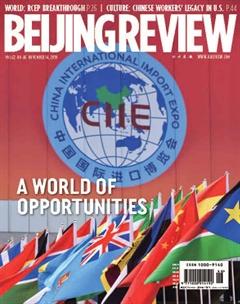Untold Stories Brought to Life
By Sherry Qin
While 2019 marks the 150th anniversary of a major milestone in U.S. history, the completion of the First Transcontinental Railroad, an over 3,000-km rail link connecting the East Coast with the West Coast, its major workforce of about 12,000 Chinese immigrants remained long forgotten, and their contributions and sacrifices little recognized.

But last month, the Museum of Chinese in America (MOCA) in New York City brought to light the untold stories in the making of the United States through the lens of the Chinese immigrant experience and redefined the American narrative with two comprehensive exhibitions. Collecting and Documenting Chinese American History and The Chinese Helped Build the Railroad–The Railroad Helped Build America opened in MOCA on October 17 and will run till March 22, 2020.
MOCA brought together descendants of the railroad workers and representatives of history societies that document the history of the Chinese to show a collective image of often neglected and discriminated-against Chinese immigrants.
“We are urgently presenting these stories; and we are eager and anxious about [them] not only because we are fraught with tensions in the bilateral relationship, [but because] we are fraught with the attention of Asian-Americans and our roles in this country,” MOCA President Nancy Yao Maasbach said.
Putting the U.S. on track
On May 10, 1869, leaders of the Central Pacifi c and Union Pacifi c Railroads, the two rail companies entrusted with building the First Transcontinental Railroad, gathered in Utah to celebrate its completion. Yet the major workforce, over 12,000 Chinese laborers, was invisible at the ceremony and remained missing in the history-telling for over a century.
In a 1927 article in The Southern Pacific Bulletin, Erle Heath, then associate editor of the publication, wrote how the Chinese workers, who were nicknamed iron workers, laid over 16 km of tracks in 12 hours back in 1869. However, none of their names were known. They were all remembered as “John Chinaman.”

In 2016, Perrone and his colleagues built a red brick monument topped with a white pagoda roof in remembrance of the Chinese immigrants in Belleville.
The day following the completion of the monument, they saw something sticking out in the immigrants cemetery. It turned out to be a seaming iron, the kind a laundry worker would use.

“For 20 years, we cleaned that cemetery and probed every square, but did not find a thing. This particular iron may or may not be from a Chinese immigrant, but the message was from the Chinese workers,” Perrone said.
“Now we are preparing for next year, which is the 150th anniversary of the Chinese coming to Belleville. We are working on constructing a dragon boat and have many activities planned,”he added.
The Chinese legacy
Gerry Low-Sabado, a fifth-generation descendant whose ancestors came from a Chinese fi shing village and then worked on the railroad, shared her familys story back to the 1850s. The 69-year-old said her ancestors sailed across the Pacifi c from China to California in an engineless boat in the 1850s and her great-grandfather Quock Tuck Lee helped build the rail line to Monterey and Pacifi c Grove.
As a community preservationist in Fremont, California, Low-Sabado has initiated the Walk of Remembrance to tell the story of the early pioneering Chinese-American fi shing village that existed in Pacifi c Grove from 1854 to 1907. The 2019 Walk of Remembrance on May 4 marked the 10th walk to honor the Chinese immigrants.
On the 150th anniversary of the completion of the last section of the railroad between Sacramento and Oakland in California, Low-Sabado attended the “true completion of the transcontinental ceremony.”
“I was trying to reclaim my ancestors real Chinese-American history and bring about a change in the play by bringing respect to the Chinese, what I call ‘change with kindness,”she said.
“With my generation, because of the Chinese Exclusion Act, my parents did not teach us Chinese. But we still carried on the traditions, like the Qingming Festival,” she said.
The 1882 Chinese Exclusion Act, prohibiting the immigration of Chinese laborers, was the earliest anti-immigration measure targeting a specifi c community and was made permanent in 1902. The Qingming Festival, also known as Tomb-Sweeping Day, is a traditional Chinese festival when families remember and pay tributes to their ancestors.
Low-Sabado showed up at the MOCA exhibition in a red traditional Chinese jacket with a straw bucket hat in hand, part of her familys fi shing heritage.
“On special occasions, I encourage my kids to come to the events to represent the next generation [of Chinese immigrants],” she said.

